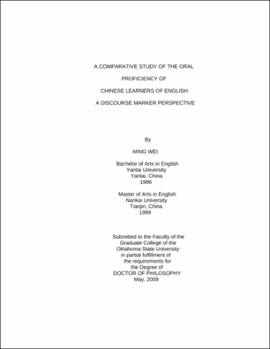| dc.contributor.advisor | Halleck, Gene B. | |
| dc.contributor.author | Wei, Ming | |
| dc.date.accessioned | 2013-11-26T08:29:36Z | |
| dc.date.available | 2013-11-26T08:29:36Z | |
| dc.date.issued | 2009-05 | |
| dc.identifier.uri | https://hdl.handle.net/11244/7088 | |
| dc.description.abstract | Scope and Method of Study: This study investigates the use of discourse markers by Chinese college-level learners of English. It compares the use of discourse markers by students at different proficiency levels. An audio-video instrument called Video Oral Communication Instrument was conducted with fifty students at a Chinese university, among which twenty, including ten intermediate and ten advanced students, were selected for transcription and analysis. Fraser's (1999) taxonomy and Stenstrom's (1994) inventory were adopted as analytical models for ideational and interactional markers respectively. Then intermediate and advanced students were compared quantitatively and qualitatively with regard to their use of ideational and interactional markers. | |
| dc.description.abstract | Findings and Conclusions: The results showed that advanced students use ideational markers to construct more hierarchical structures, and mark more major discourse divisions to indicate the relevance of particular utterances in the hierarchy of meanings. Advanced students also resort to ideational markers to help fulfill more interactive purposes. They are generally better able to use ideational markers more effectively to construct coherent spoken discourse. Intermediate students are relatively more concerned with text-related issues; their spoken discourse attends more to the transactional aspect of communication. Meanwhile, their effort of transmitting factual information is not necessarily effective in terms of the integration of discourse units since their ideational markers are often used at a more local level and in a sequential manner. With regard to interactional markers, advanced students are more likely than intermediate students to use interactional markers in their spoken discourse; they are relatively more involved in the interactive context. | |
| dc.description.abstract | The discrepancy in ideational and interactional marker use between intermediate and advanced students in this study indicates that proficiency level does relate to the way DMs are used. This study also suggests that contextual variations affect ideational and interactional marker use across proficiency levels. Another important implication is that it is necessary to consider variety and specific use in addition to quantity when examining discourse markers. | |
| dc.format | application/pdf | |
| dc.language | en_US | |
| dc.rights | Copyright is held by the author who has granted the Oklahoma State University Library the non-exclusive right to share this material in its institutional repository. Contact Digital Library Services at lib-dls@okstate.edu or 405-744-9161 for the permission policy on the use, reproduction or distribution of this material. | |
| dc.title | Comparative study of the oral proficiency of Chinese learners of English: A discourse marker perspective | |
| dc.contributor.committeeMember | Moder, Carol Lynn | |
| dc.contributor.committeeMember | Cheng, An | |
| dc.contributor.committeeMember | Kennison, Shelia M. | |
| osu.filename | Wei_okstate_0664D_10238 | |
| osu.accesstype | Open Access | |
| dc.type.genre | Dissertation | |
| dc.type.material | Text | |
| dc.subject.keywords | chinese learners | |
| dc.subject.keywords | discourse marker | |
| dc.subject.keywords | english | |
| dc.subject.keywords | oral proficiency | |
| thesis.degree.discipline | English | |
| thesis.degree.grantor | Oklahoma State University | |
